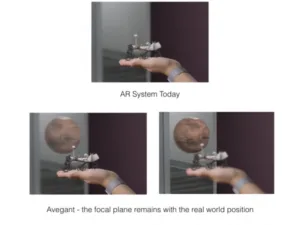Avegant, the maker of the Glyph video viewing headset, announced a new display technology that allows them to create a light field display that is useable for a near to eye headset. This technology would be very useful in A, V, M-R applications. According to their press release, they have been showing their new technology with a proof of concept headset that has been around at least since the beginning of the year.
The main advantage of their technology is a claim of excellent virtual image clarity, simple software development and easy hardware integration. This may mean that they see a real image quality advantage that allows to create content in an easy way based on existing workflows. In addition they are looking to sell their technology to other tech companies to incorporate them into OEM specific designs. Avegant has also linked to a YouTube video on its website that shows off what the technology is able to accomplish.
Analyst Comment
This announcement is relatively new, but as a matter of fact it does not add anything new to the information that was gathered at CES 2017. For an excellent discussion of the technology as far as it was disclosed, take a look at our friends ‘Karl Guttag – Avegant Light Field Display” article. This also demonstrates that an actual headset existed back in January 2017, even though we do not know if this is still the same headset or an even more refined version.
Source: Avegant Light Field Display
In summary the technology is based on a DMD projection solution that allows Avegant to create multiple focus planes to solve the vergence / accommodation issue. This press release does not add any more revelations on how Avegant is achieving this or how may focus planes they are actually creating. As the image above demonstrates, when you put an AR object on a specific real world object (like your hand) the focal planes may not match very well. This means that your eyes bring your hand into focus, but the object is not, as most AR systems put AR objects several feet away from the viewer.
The Avegant solution offered several focal planes and interpolates between them. This makes it possible to put the AR object on the same focal plane as the hand. As a consequence, if you focus your eyes on an object further away, the hand as well as the AR object will go out of focus or vice versa, as is shown in the lower two images. This makes the AR experience much more real and eliminates particular eye strain issues for the viewer. Many viewers of the Avegant headset have rated it as being a level above the Microsoft HoloLens headset. (NH)

